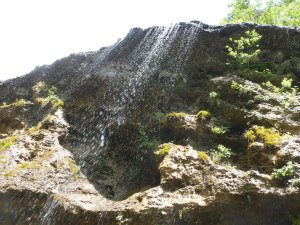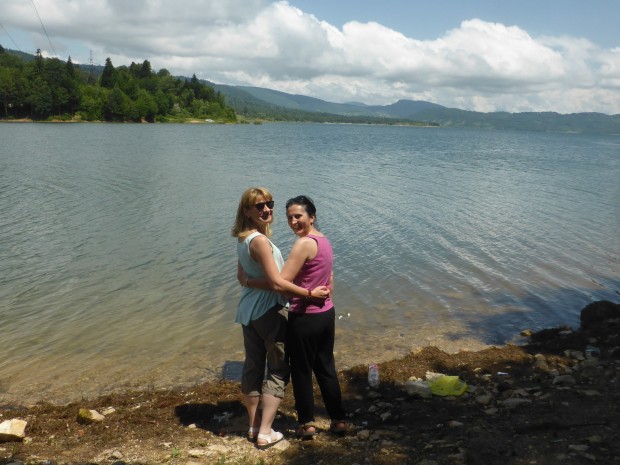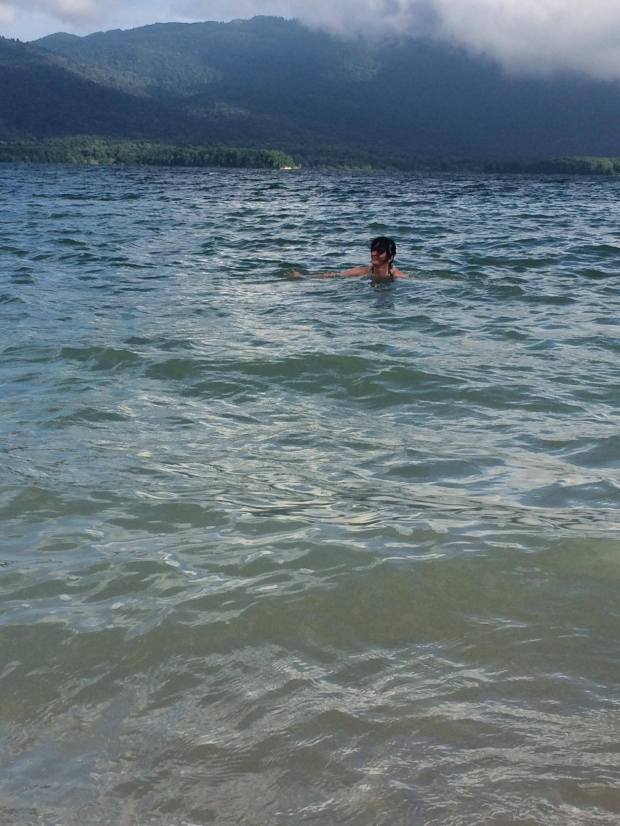
Meeting up in Rustaveli
Tbilisi is stiflingly hot in August, it seemed like a good time to head to the cooler mountainous regions of Georgia. This trip was taken over two days with “აბოდიალებულები” (which roughly translates as “the wanderers”) in a 4 x 4 Mitsubishi Delica driven by Dato. We met at the big bicycle sculpture at Rustaveli for an early 7am start.

Mitsubishi Delica…ideal for carrying 9 people on rough tracks
Khevsureti is s a historical-ethnographic region in north eastern Georgia, to the north of the region is Chechnya, it is on the slopes of the great Caucasus mountain range. The architecture of Khevsureti is mostly highly fortified and defensive in character,featuring a profusion of towers clinging to the mountainsides,signifying constant vigilance in the face of enemy attack. The Khevsurs were renowned for their warfare with the (mostly Muslim) peoples of the Northern Caucasus including the Chechens, the Kists and the many peoples of Dagestan.

Khevsureti
Our first cultural stop en route is at Korsha to visit the Khevsureti Ethnographic Museum.

Khevsureti Ethnographical Museum
The museum holds two rooms of dusty artefacts, old musical instruments, Georgian costume, and some paintings, including a painting of Shatili which is where we were heading.

A picture of Shatili, where we are heading.

How do I look?
After the museum we went to Bear’s Cross, a high mountain pass, where we met some intrepid Polish cyclists from Wroclaw, who had managed to get a lift to the top of the mountain pass on a Kamaz truck.

Polish cyclist and Maka
Then we headed on to the Weeping Mountain.

Weeping Mountain

group photo under the weeping mountain

Natural Minibus wash
The landscape of Khevsureti is breathtaking, mountains, rivers, flowers….

Khevsureti
Mutso, almost completely abandoned more than a century ago, is a home to approximately 30 medieval fortified dwelling units arranged on vertical terraces above the Mutso-Ardoti gorge, four combat towers and ruins of several old structures and buildings. Difficult to access, the village retains original architecture, and is a popular destination for tourists and mountain trekkers. Listed, however, among the most endangered historic monuments of Georgia, a project of the rehabilitation of Mutso has been developed since 2004. We had the privilege of seeing workers restoring the towers using traditional materials. Our walk up to Mutso was preparation for our long walk on Sunday.

Walking up to Mutso
On the way up there were some creepy Anatori Crypts, medieval communal tombs with human bones still visible.

Anatori Crypts, medieval communal tombs with human bones still visible.
In times of plague infected villagers would voluntarily enter these tombs and wait for death.

Anatori Crypts, medieval communal tombs with human bones still visible.

Workers restoring Mutso
After Mutso we had a look at Ardoti and got a bit lost, luckily Dato drove back to pick us up and take us to our guest house in Shatili. Before sleeping, we ate our ritual supra (Georgian feast), the Khinkhali was a little disappointing, but as with Georgian supras, we had far too much to eat.

Supra with Khinkhali in the guest house
The second day of our trip comprised of a morning wandering about Shatili and an afternoon, were we walked and walked for hours to reach a couple of lakes.
Full Georgian Breakfast means Khachapuri, a sort of cheese bread.
Shatili, I think of as a Georgian Macchu Picchu, not that I have ever visited Peru, and it may not be the best comparison. A partially abandonned city set in the mountains. Shatili’s old town, built between the 7th and 13th centuries, is a unique agglomeration of tall koshkebi (towers) clinging together on a rocky outcrop to form a single fortress-like whole.

Khachapuri

Shatili : A Georgian Macchu Picchu?
The houses were abandonned between the sixties and the eighties.

Steps are good for group photos: say “Sulguni” (Georgian cheese)

Shatili from below.
After Shatili it was back in the Delica headed for Lake Abudelauri and a very long walk.

Taking in some calories for the long walk ahead.
From the village of Roshka to the first lake of the Abudelauri lakes (the green one) it took us three hours of uphill walking in hot sun, quite a challenge. I covered up as much as I could not wishing to get sunburnt, the strong Georgian sun had caught me out in previous summers.

covered up against strong Georgian sun

Abudelauri Lake (green)

taking a breather en route
The green lake was a little disappointing, the blue lake was very blue and the white lake we didn’t visit as it would mean a further one and a half hour walk.

Abudelauri Lake (Blue)
We met our friend Damian and his hiking buddies at the lake, it can seem a small world at times. Our walking took from 1.30 pm to 8pm, that is a lot of walking for someone like me used to sitting at a computer, my legs are feeling the journey today (Monday). It was a good trip, but quite tiring. Khevsureti is magnificent.

Maka and Maia take a break on the walk back.


















































































